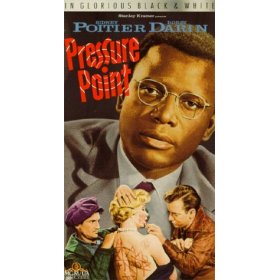
PRESSURE POINT
US, 1962, 80 minutes, Black and white.
Sydney Poitier, Bobby Darin, Peter Falk, Carl Benton Reid.
Directed by Hubert Cornfield.
Pressure Point is a short but telling message film that tackles a number of issues very sincerely, perhaps at times a little too sincerely in a way. It fits into the cycle of Sidney Poitier films that show him as good and heroic (A Patch of Blue; The Slender Thread; To Sir With Love; Guess Who's Coming to Dinner) although it pre-dates these by some years. In 1963 he won the Oscar for Lilies of the Field.
Bobby Darin has acted effectively in several films. Here he has quite an unsympathetic role which he handles well. Direction is by Hubert Cornfield who made the Marion Brando drama (banned in Australia in 1969), The Night of the Following Day, later seen on television. Pressure Point is a good film on racism, America, psychiatry and mental illness.
1. What was the Pressure Point referred to in the title?
2. Was the structure of the film effective - setting, central flashback, commentary by Poitier, Darin's childhood and past, his fantasies and dreams? How else would this story have been told?
3. How important was the message of racism in the film?
4. Was Sidney Poitier's character credible, likeable? The effect of seeing him as older advising a younger doctor? What was the point of telling his story?
5. What did the war setting, prison, psychiatry, black and white photography add to the film?
6. What were your first impressions of the patient? Sympathy in spite of his hostility? Did he need treatment and did the doctor offer this to him?
7. Did the doctor allow personal hostility to interfere with his treatment? Was he right in attempting to refuse the case? Was he ultimately successful in getting a positive response from the patient?
8. How interesting was the case history of the patient? The doctors remarked that there were a million men in similar situations but had coped. Why hadn't this patient?
9. What did the film have to offer on right-wing tendencies in people, the paranoia of fascists and appeal of extreme fascism to such personalities; their fear of personal violence yet advocating extreme violence? The patient's Nazism in relation to African Americans (better than Jews - they could be identified without a star)?
10. The individual optimism of each and their clash - that Fascist liberty would win and the Doctor's view that sanity would keep winning? The patient's taunt that the Doctor was dreaming - his United States did not even accord him the equality of the Constitution?
11. What is the impact of a film like this in "educating" audiences to balanced and 'normal' ideas and attitudes? Why? How?
12. Details of the case history: the turns, seeing himself (then his father) struggling in the sink; his lonely childhood; neurotic mother; the drunken father and the girl and his love for his mother; destructive games at school; his dislike of blood - the incident with the liver; his potentate fantasy and the elephant treading on him; his work after school; his meeting with the fascists; his going to Nazi meetings and signing up; his visual presentations of how the Nazis grow in number and build up funds; the rally; the aims of the Nazis; his arrests; the Doctor's analysis of why he joined the Nazis. The film informed us quietly of the execution of the patient and showed us the Doctor's success. Was this a convincing optimistic view?